
Artemisia is a large, diverse genus of plants belonging to the daisy family Asteraceae, with between 200 and 400 species. Common names for various species in the genus include mugwort, wormwood, and sagebrush.
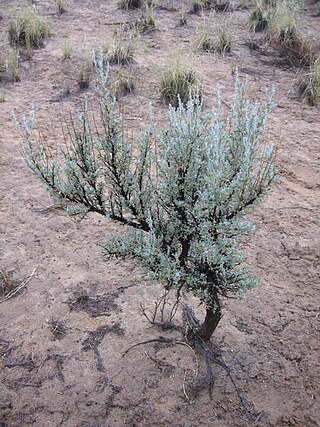
Artemisia tridentata, commonly called big sagebrush, Great Basin sagebrush or (locally) simply sagebrush, is an aromatic shrub from the family Asteraceae, which grows in arid and semi-arid conditions, throughout a range of cold desert, steppe, and mountain habitats in the Intermountain West of North America. The vernacular name "sagebrush" is also used for several related members of the genus Artemisia, such as California sagebrush.

Artemisia abrotanum, the southernwood, lad's love, or southern wormwood, is a species of flowering plant in the sunflower family. It is native to Eurasia and Africa but naturalized in scattered locations in North America. Other common names include: old man, boy's love, oldman wormwood, lover's plant, appleringie, garderobe, Our Lord's wood, maid's ruin, garden sagebrush, European sage, sitherwood and lemon plant.
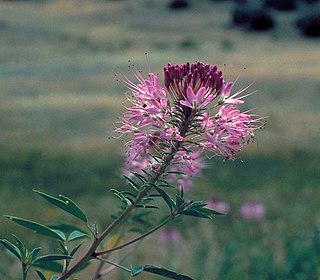
Cleome serrulata, commonly known as Rocky Mountain beeplant/beeweed, stinking-clover, bee spider-flower, skunk weed, Navajo spinach, and guaco, is a species of annual plant in the genus Cleome. Many species of insects are attracted to it, especially bees, which helps in the pollination of nearby plants. It is native to southern Canada and the western and central United States. The plant has often been used for food, to make dyes for paint, and as a treatment in traditional medicine.

Ericameria nauseosa, commonly known as chamisa, rubber rabbitbrush, and gray rabbitbrush, is a shrub in the sunflower family (Aster) found in the arid regions of western North America.

Lithospermum incisum is a species of flowering plant in the borage family known by several common names, including fringed puccoon, narrowleaf stoneseed, fringed gromwell, narrowleaf puccoon, and plains stoneseed. It is native to much of central Canada and the United States, where it is known from many types of habitat, but particularly piñon-juniper woodland. It is a hairy perennial herb growing from a narrow brown to black taproot and woody caudex. It produces a cluster of stems up to about 30 centimeters long. The stems are lined with narrow, pointed leaves up to 6 centimeters long. The slender, trumpet-shaped flowers are pale to bright yellow or gold, and may approach 4 centimeters long. The corolla face is 1 to 2 centimeters wide, its lobes sometimes ruffled. The smaller cleistogamous (closed) flowers are the main producers of seed.

Cycloloma is a monotypic genus which contains the sole species Cycloloma atriplicifolium, which is known by the common names winged pigweed, tumble ringwing, plains tumbleweed, and tumble-weed. This plant is native to central North America, but it is spreading and has been occasionally reported in far-flung areas from California to Maine to the Canadian prairie. It is considered an introduced species outside of central North America. This is a bushy annual herb forming a rounded pale green clump which may exceed 0.5 m in height. It is very intricately branched, with toothed leaves occurring near the base. The spreading stems bear widely spaced flowers are small immature fruits fringed with a nearly transparent membranous wing. In autumn, the plant forms a tumbleweed. The fruit is a utricle about 2 millimeters long containing a single seed.

Chaetopappa ericoides is a species of flowering plant in the family Asteraceae known by the common names rose heath and heath-leaved chaetopappa. It is native to the southwestern and western Great Plains regions of the United States, plus northern Mexico. It is found in California, Nevada, Arizona, Utah, New Mexico, Colorado, Wyoming, Texas, Oklahoma, Kansas, Nebraska, Chihuahua, Coahuila, Sonora, Durango, Zacatecas, San Luis Potosí, and Nuevo León.

Artemisia campestris is a common and widespread species of plants in the sunflower family, Asteraceae. It is native to a wide region of Eurasia and North America. Common names include field wormwood, beach wormwood, northern wormwood, Breckland wormwood, boreal wormwood, Canadian wormwood, field sagewort and field mugwort.
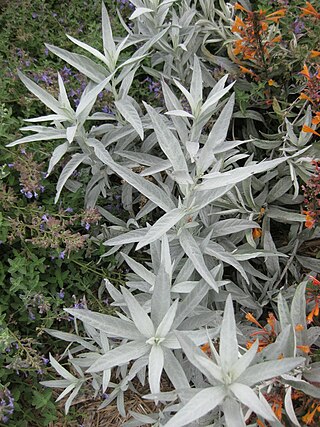
Artemisia ludoviciana is a North American species of flowering plant in the daisy family Asteraceae, known by several common names, including silver wormwood, western mugwort, Louisiana wormwood, white sagebrush, lobed cud-weed, prairie sage, and gray sagewort.

Ephedra nevadensis, commonly known as Nevada ephedra, gray ephedra, Mormon tea and Nevada jointfir, is a species of gymnosperm native to dry areas of western North America.

Artemisia nova is a North American species of sagebrush, known by the common name black sagebrush. It is "one of the most common shrubs in the western United States".
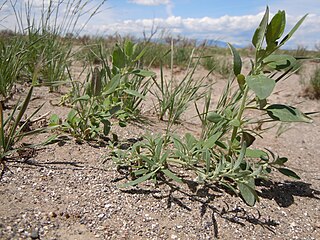
Chenopodium leptophyllum is a species of flowering plant in the family Amaranthaceae known by the common name narrowleaf goosefoot.

Dieteria canascens is an annual plant or short lived perennial plant in the family Asteraceae, known by the common names hoary tansyaster and hoary-aster.

Yucca glauca is a species of perennial evergreen plant, adapted to xeric (dry) growth conditions. It is also known as small soapweed, soapweed yucca, Spanish bayonet, and Great Plains yucca.

Artemisia cana is a species of sagebrush native to western and central North America, a member of the sunflower family. It is known by many common names, including silver sagebrush, sticky sagebrush, silver wormwood, hoary sagebrush, and dwarf sagebrush.

Zinnia grandiflora is a species of flowering plant in the family Asteraceae known by the common names Rocky Mountains zinnia and plains zinnia. It is native to the southwestern and south-central United States and northern Mexico.

Artemisia norvegica is a species of flowering plant in the aster family known by the common names alpine sagewort, boreal sagewort, mountain sagewort, Norwegian mugwort, arctic wormwood, and spruce wormwood. It is found in cold locations in Eurasia and high altitudes and high latitudes in North America.
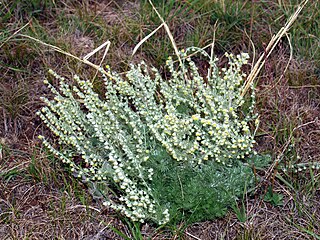
Artemisia frigida is a widespread species of flowering plant in the aster family, which is known as the sunflower family. It is native to Europe, Asia, and much of North America. In parts of the north-central and northeastern United States it is an introduced species.
This is a list of plants and how they are used in Zuni culture.




















